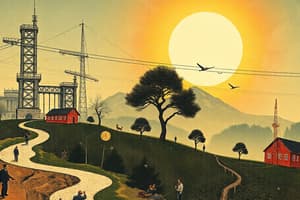Podcast
Questions and Answers
The average air temperatures near Earth's surface have gone up about 2 degrees ______ in the last century.
The average air temperatures near Earth's surface have gone up about 2 degrees ______ in the last century.
Fahrenheit
As Earth warms, NASA has observed that sea levels are ______.
As Earth warms, NASA has observed that sea levels are ______.
rising
Melting ice from glaciers and ice sheets flows into the ______.
Melting ice from glaciers and ice sheets flows into the ______.
oceans
Ocean ______ is a phenomenon that can be harmful for marine life.
Ocean ______ is a phenomenon that can be harmful for marine life.
As warm water gets ______, it takes up more room in the oceans.
As warm water gets ______, it takes up more room in the oceans.
Climate change describes a change in the typical weather for a region — such as high and low temperatures and amount of ______ — over a long period of time.
Climate change describes a change in the typical weather for a region — such as high and low temperatures and amount of ______ — over a long period of time.
Scientists have observed that, overall, Earth is ______.
Scientists have observed that, overall, Earth is ______.
The rise in global temperature is sometimes called ______.
The rise in global temperature is sometimes called ______.
Some of the gases in Earth’s atmosphere trap heat from the Sun—like the glass roof and walls of a ______.
Some of the gases in Earth’s atmosphere trap heat from the Sun—like the glass roof and walls of a ______.
Human activities, such as the destruction of forests and burning fossil fuels, create extra ______ gases.
Human activities, such as the destruction of forests and burning fossil fuels, create extra ______ gases.
When we burn fossil fuels, the carbon that was in the ground goes into the air as a gas called ______.
When we burn fossil fuels, the carbon that was in the ground goes into the air as a gas called ______.
Plants and trees can absorb some of this extra carbon dioxide, but a lot of it stays in the atmosphere as a ______ gas.
Plants and trees can absorb some of this extra carbon dioxide, but a lot of it stays in the atmosphere as a ______ gas.
Over millions of years, Earth's climate has warmed up and cooled down many times, often influenced by the ______ activity.
Over millions of years, Earth's climate has warmed up and cooled down many times, often influenced by the ______ activity.
Flashcards
Global Warming
Global Warming
The planet is warming at an accelerated rate compared to historical trends.
Sea Level Rise
Sea Level Rise
The average height of the ocean's surface is increasing due to melting ice and the expansion of warmer water.
Melting Ice
Melting Ice
Glaciers and ice sheets are shrinking due to rising temperatures, adding more water to the oceans.
Ocean Acidification
Ocean Acidification
Signup and view all the flashcards
Impacts of Climate Change
Impacts of Climate Change
Signup and view all the flashcards
Climate vs. Weather
Climate vs. Weather
Signup and view all the flashcards
Climate Change
Climate Change
Signup and view all the flashcards
Greenhouse Gases
Greenhouse Gases
Signup and view all the flashcards
Fossil Fuels
Fossil Fuels
Signup and view all the flashcards
Carbon Dioxide (CO2)
Carbon Dioxide (CO2)
Signup and view all the flashcards
Sun's Activity and Climate Change
Sun's Activity and Climate Change
Signup and view all the flashcards
Natural Climate Change
Natural Climate Change
Signup and view all the flashcards
Study Notes
Global Temperature Increase
- The average air temperatures near Earth's surface have gone up about 2 degrees Fahrenheit in the last century.
- As Earth warms, NASA observed that sea levels are rising
- Melting ice from glaciers and ice sheets flows into the ocean.
Ocean Acidification
- Ocean acidification is a phenomenon that can be harmful for marine life
- As warm water gets warmer, it takes up more room in the oceans.
Climate Change Data
- Climate change describes a change in the typical weather for a region, such as high and low temperatures and amount of rainfall, over a long period of time.
- Scientists have observed that, overall, Earth is warming.
- The rise in global temperature is sometimes called global warming.
Greenhouse effect
- Some of the gases in Earth’s atmosphere trap heat from the Sun, like the glass roof and walls of a greenhouse
- Human activities, such as the destruction of forests and burning fossil fuels, create extra greenhouse gases.
- When we burn fossil fuels, the carbon that was in the ground goes into the air as a gas called carbon dioxide
- Plants and trees can absorb some of this extra carbon dioxide, but a lot of it stays in the atmosphere as a greenhouse gas.
- Over millions of years, Earth's climate has warmed up and cooled down many times, often influenced by the sun’s activity.
Studying That Suits You
Use AI to generate personalized quizzes and flashcards to suit your learning preferences.



